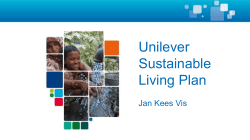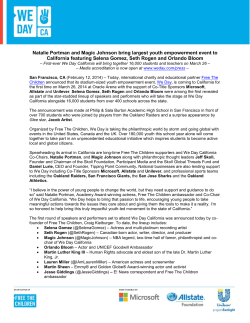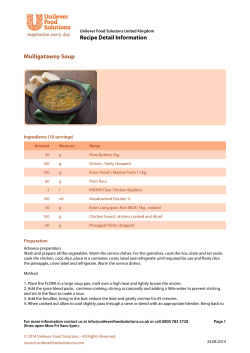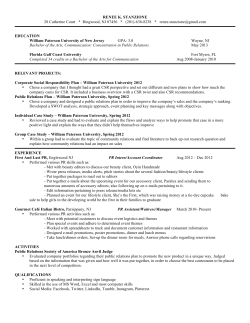
Document 170803
UNIVERSITY OF NEWCASTLE MA MEDIA & PUBLIC RELATIONS Theoretical Approaches to PR (COM8065) A report on the current usage of Corporate Social Responsibility on the example of Unilever’s “Sustainable Living Plan” By Julia Buschmann (110452490) Laurel Hetherington Submission: 9 December 2011 1 Report of the Sustainable Living Plan Small Actions. Big Difference. 2 Content The Unilever emporium ............................................................................ 4 Strategy .................................................................................................... 4 Analysis and critical evaluation ................................................................ 7 Results of the Sustainable Living Plan .................................................. 11 Final suggestions ................................................................................... 12 Graphics and tables: List 1: CSR effects on stakeholders .......................................................................... 5 Graphic 1: How CSR is important ............................................................................. 6 Graphic 2: Carroll's Pyramid ....................................................................................... 7 Table 1: Overall Results ......................................................................................... 10 Abbreviations: CEO Chief Executive Officer CSR Corporate Social Responsibility 3 GHG Greenhouse Gases R&D Research and Development SusLivPlan Sustainable Living Plan The Unilever emporium As one of the world leaders in consumer products Unilever constantly finds itself in the focus of potential critics and pressure groups, among them journalists, environmentalists, consumer protection groups or consumer representatives1. 2 As a response to criticism and to double its growth it launched “The Sustainable Living Plan” (hereafter SusLivPlan) in November 2010. Now, one year after the launch, it is worth to have a look at its success, its overall implementation and critically evaluate in how far Unilever applies to common CSR theories. Strategy 1 2 See Corporate Watch for examples: <http://www.corporatewatch.org/?lid=260> [Accessed 1 December 2001] http://www.positiv-‐magazin.de/?p=9095 [Accessed 25 November 2011] 4 The SusLivPlan is Unilever’s business plan for one decade. It attempts to include CSR throughout its core business taking in its products, departments, consumers, suppliers and local communities. The emerging markets offer the greatest possibilities for Unilever to increase its turnover.3 Consumers here are also more likely to buy brands that support good causes. For instance, 81% of the Brazilians, 78% of the Chinese and Mexicans as well as 77% of the Indians would trust a brand that is ethically and socially responsible. The global average still lies at 65%.4 Investing in ethically responsible products gives people the outright feeling of doing something good for the world. “A growing number are choosing to buy brands such as Rainforest Alliance Certified Lipton tea, Ben & Jerry’s Fairtrade ice cream and “small & mighty” concentrated laundry detergents.” Unilever5 The overall awareness of society towards CSR evidently has risen and it holds commercial value.6 CSR activities hold many advantages. ü Journalists have something positive to report to their readership ü Critiques can be outweighed ü Current employees like their employer and become loyal ambassadors ü Consumers tend to buy more and build long-term relationships ü Potential consumers and employees become attracted ü Shareholders and investors are more likely to invest ü Suppliers establish stronger relationships ü Government(s)/regulators become/s more supportive 3 http://www.unilever.com/aboutus/introductiontounilever/unileverataglance/ [Accessed 25 November 2011] Edelman (2010: 13): http://www.edelman.com/insights/special/GoodPurpose2010globalPPT_WEBversion.pdf [Accessed 1 December 2011] 5 Unilever’s Sustainable Living Plan (2011: 5) 6 Cf. Tench and Yeomans (2009: 103) Exploring PR. Harlow: Prentice Hall. 4 5 ü Communities accept local plants and tend to hold positive attitude List 1: CSR effects on stakeholders Enhanced reputation and trust among stakeholders can have an impact on a chain of factors that eventually culminates in greater profits: • Corporate Social Responsibility • Good social and ethical reputation • Trust |Long-term relationships | Support by stakeholders • Higher productivity, higher turnovers, increasing market shares,... • Overall higher corporate profile | Competitive Advantages • Liquid assets and profitability Graphic 1: How CSR is important Here CSR entirely serves as a driver of growth and profitability. The economist Milton Friedman claims: “The social responsibility of business is to use its resources and engage in activities designed to increase its profits.”7 Unilever CEO Polman holds a similar perspective: “It is our strategy – not a CSR-type appendix to our business. It is the core of our business. “Most business operators say ‘How can I use society and the environment to be successful?’. We’re asking ‘How can we contribute to society and the environment to be successful?’ Though this might require more challenges and innovation, our model is the bigger growth 7 nd Friedman, M. (1970) in Theaker, A. (2008: 136) The PR Handbook. (2 ed.) London: Routledge. 6 driver in the end.” Polman in an interview with Future Forum about the “Sustainable Living Plan” 8 Analysis and critical evaluation Let us keep Polman’s comment in mind when evaluating the SusLivPlan critically and analyse how high the kind CSR approaches actually rank. Archie B. Carroll has developed four levels of social responsibility; these can be depicted as a pyramid: Philan-‐ thropic responsibiliees Charitable acts – not necessarily expected by society Level 4 Level 3 Ethical responsibilites Level 2 Higher CSR responsibility Legal reponsibilites Basic business responsibilities Level 1 Economic responsibilites Graphic 2: Carroll's Pyramid 8 http://www.marketingmagazine.co.uk/bulletin/dailynews/article/1105270/?DCMP=EMC-‐ BreakingnewsfromMarketing [Accessed 25 November 2011] 7 Each level holds more detailed criteria within, which were taken into account for this evaluation.9 A whole range of actions were released to approach three target issues.10 A. Health and well-Being Targets 1.-12. Unilever promotes its consumer products as contributions to society’s health, hygiene and well-being. Particular consumers in emerging countries are targeted with Unilever’s soap brands, water purifier and toothpaste. Unilever attempts to promote and sell products among a wider and greater audience. Its goal to expand into developing markets once more becomes clear. >> Targets on Level 1 and 2 as basic business responsibilities B. Reduce environmental impact Targets 13.-26. Unilever focuses on consumer use rather than on its own impact. They mention that transport and manufacturing make “just 5%” of total GHG whereas sourcing raw material, apparently the biggest contributor from Unilever’s side, is added to consumer use – almost as if Unilever veils the impact it can control with the consumers’ impact, which they cannot have direct influence on. CSR actions involve changing individual consumer behaviour in order to reduce their footprint when using Unilever products (“turn 9 Please see appendix pp. 22 for evaluation components. 10 Due to the complexity of the SusLivPlan targets have been grouped. See appendix for details. 8 off the tap” principle). YouTube videos, smartphone apps, interactive games and educational programmes in the Web 2.0 shall help implement these intentions. They also function as marketing. Reduction, reuse and recycling of its packaging join the attempts to save water and GHG. Strikingly, definitions of ‘greenwashing’ list the exact same approaches. “Greenwashing occurs when a company touts that changes to a product were environmentally motivated, when they were motivated by financial gain… Companies have rolled out new ‘green’ programmes for energy and material inputs, packaging, and logistics that in fact save them money.”11 Unilever also wants to minimise its footprint in transports, storage and manufacturing. >> Targets on Level 1 and 2 as reductions provide cost efficiency and educational programmes on how to use products mainly serve promotion purposes Targets 27.-35. To source sustainably Unilever works with Fairtrade, Oxfam and mainly the Rainforest Alliance (e.g. Lipton & PGTips). The Rainforest Alliance has a controversial reputation as offering companies a cheap and short-term marketing advantage.12 Greenpeace accused Unilever for years of refusing to purchase fairly traded tea. Heavy criticism also regarded unethical palm oil 11 Cohen, N. (2010: 305) Green Business. Thousand Oaks: Sage See appendix p. 20. 12 9 sourcing13. Greenpeace campaigns forced Unilever towards change – another element in its plan.14 With regard to the rising awareness among stakeholders Unilever has reacted to newly evolving ethical moral norms adopted by society (e.g. Ben & Jerry Fairtrade). >> Unilever reaches Carroll’s Level 3 C. Enhancing Livelihoods Targets 36.-37. Unilever works with Oxfam.15 Smallholder farmers become linked to Unilever’s supply network and get equipped and trained. This way Unilever also increases its productivity. The same counts for “supporting” “Shakti”entrepreneurs.16 Unilever trains and recruits staff that sells and promotes its products in rural areas. >> Level 1 and 2 Unilever also has established a study with Oxfam over many years; investigating the impacts of international business on poverty. Unilever here assists projects that enhance a community’s “quality of life” and contributes its expertise to educational programmes and researches. >> Level 4 Results Overview 26 targets reach… Levels 1 and 2 - 8 targets reach… Basic business responsibilities Level 3 - Adaption to emerging ethical norms in society 13 Cf. Greenpeace magazine <http://www.greenpeace-‐magazin.de/index.php?id=2666> [Accessed 7 December 2011] 14 Cf. Greenpeace <http://www.greenpeace.org/international/en/campaigns/forests/asia-‐pacific/dove-‐palmoil-‐ action/> [Accessed 6 December 2011] 15 See appendix p. 20-‐21. 16 See appendix p. 21. 10 2 targets reach… Level 4 - communities Level 1 + 2 Level 3 Level 4 Projects to enhance livelihoods of - Assistance to educational programmes and study research 17 Table 1: Results Profitability is the foundation on which all responsibilities are built and together with legal components it is mandatory in terms of running a business. All of Unilever’s targets match these levels. Ethical behaviour and philanthropy provide higher CSR responsibilities, contributing to society.18 Unilever takes philanthropic attempts to increase the livelihoods of communities and to be a good corporate citizen. Doubtlessly these actions also benefit its recruitment, turnovers, reputation and research in emerging markets. Yet, they match Carroll’s components. Many actions seem to be on Level 3 or 4 on Carroll’s pyramid at first sight as Unilever communicates them as exclusive efforts to go green. On a closer look particularly those targets aiming at reducing GHG, water and waste can be judged as green washing. They are communicated as efforts towards sustainability – although they mainly provide cost effectiveness, productivity, marketing and promotion. Results of the Sustainable Living Plan Unilever gave itself a thorough green look (“green sheen”) in order to increase profitability. CEO Polman openly claims to increase growth by contributing to society and reducing its environmental impacts. Unilever communicates transparent and honest. Yet, a significant number of its CSR actions can be claimed ‘greenwash’. 17 Note: Due to the target groupings and the complexity of the SusLivPlan these results shall just provide an idea of how far Unilever commits itself to sustainability. Further investigation would include concrete actions (e.g. specific education programmes) and evaluate their levels again. 18 Cf. Carroll, A. B. The Pyramid of CSR. In Burchell, J. (2008: 94) “The CSR Reader”. London: Routledge. 11 Nevertheless, the strategy achieves recognition and the CSR mix of philanthropy and greenwash indeed influences Unilever’s reputation positively. For their CSR actions Unilever has received several awards and recognitions.19 Many awards though should be viewed critical with regard to their actual meaningfulness. Stakeholders recognise Unilever’s efforts to go green (as seen throughout social media channels). When looking for criticism on Unilever’s plan search engine results provide positive content. With its CSR mix Unilever has reacted to the overall trends of society. The SusLivPlan provides Unilever with higher credits in the reputation bank.20 With its philanthropic actions, its thorough marketing and promotion of green, healthy and nutritious products, the use of various PR tools to promote its SusLivPlan, its awards and positive recognition and also with regard to the successful CSR effects on its stakeholders (see list 1 of this report) Unilever gains a total credit of 7 out of 10 (as opposed to a possible 4 before the plan was launched – due to criticism by pressure groups). They do not get 10 due to greenwashing and the relatively fresh launch of its concept – not all targets were met yet. Final Suggestions Companies must be clear on what motivates its CSR strategy21, as for Unilever this is growth. Friedman’s view that it all comes down to profit in the end; that even CSR only serves the goal of profitability, may not be too far off. Successful businesses must be accountable – ideally in accordance with Carroll’s upper levels. With the digital age on its edge, news, inside views, criticism and opinions by pressure groups and opinion leaders reach a greater audience faster than ever before. Social media, easy access, English as lingua franca and multiple authorship enable thorough communication and networking across the globe. 19 See <http://www.unilever.com/sustainability/introduction/awards/index.aspx> for further information. Cf. Moloney, K. (2006: 19) Rethinking PR. London: Routledge. 21 CIPR Guide by The Corporate Citizenship Company 20 12 On the long run greenwashing is a hopeless attempt for a company in order to promote its products. Though efficient and sufficient communications are mandatory, actual behaviour will be what organisations eventually gain credit for.22 As research studies have proved that emerging markets value philanthropy, Unilever should further invest in philanthropic and ethical responsibilities. Particularly with regard to its goals in emerging markets, this CSR approach will carry returns. Coherent links to their products help: E.g. water purifiers donated to schools, hospitals or employees in poor countries. Unilever should increase co-operations with Fairtrade and NGOs and learn from them. They should ensure that criticism does not emerge again due to popular accusations of animal testing, child labour or toxic landfill. Only if Unilever acts align with Carroll’s top levels, i.e. respect moral norms, be a good corporate citizen and assist projects to enhance livelihoods, it will sustainably be credited a sustainable corporation. Word count: 1.588 (excluding tables, graphics and headlines) 22 Also cf. Griffin, A. (2008: 157) New Strategies for Reputation Management. London: Kogan Page 13 Appendix CSR Report on Unilever’s Sustainable Living Plan 14 Please note: If not stated otherwise in footnotes, all the information provided is either taken from the Unilever website http://www.sustainable-living.unilever.com/ or its Sustainble Living Plan-pdf file < http://www.uslp.unilever.com/wpcontent/uploads/2010/10/UnileverSustainabilityPlan2.pdf>. The appendix therefore holds rather company biased information and only serves as object to the reports investigation. Three clear targets for 2020 are set within Unilever’s strategy: ü Improve health and well-being of one billion people ü Halve the carbon footprint of Unilever products ü Enhance the livelihoods of its suppliers through 100% sustainable sourcing. Improving Health and Well-‐Being Reducing Environmental Impact Enhancing Livelihoods Hygiene NutriKon Greenhouse Gases Water Waste Sustainable Sourcing BeLer Livelihoods The Dimensions of Unilever’s Sustainable Living Plan 15 Unilever has divided these sub-targets into about 37 more detailed goals: Hygiene Nutrition Greenhouse Gases (GHG) Water Waste Sustainable Sourcing 1. Reduce diarrhoeal and respiratory disease 6. Improve heart health 13. Reduce GHG from skin cleansing and hair washing 18. Reduce water use in the laundry process 21. Reduce packaging 7. Reduce salt levels 14. Reduce GHG from washing clothes 19. Reduce water use in skin cleansing and hair washing 22. Reuse packaging Sustainable... 27. palm oil 28. paper and board 29. soy 30. tea 31. fruit and vegetables 32. cocoa 33. sugar, sunflower oil, rapeseed oil and dairy 2. Improve oral health 8. Reduce saturated fat 15. Reduce GHG from manufacturing 9. Remove trans fat 4. Improve self-esteem 5. Provide safe drinking water 10. Reduce sugar 11. Reduce calories 16. Reduce GHG from transport 17. Reduce GHG from refrigeration 12. Provide healthy eating information 20. Reduce water use in our manufacturing process 23. Recycle packaging 24. Reduce waste from our manufacturing 34. Fairtrade Ben & Jerry’s 35. Cage-free eggs 25. Tackle sachet waste 26. Eliminate PVC Better Livelihoods 36. Helping smallholder farmers 37. Supporting micro-entrepreneurs To reduce the complexity I have grouped the targets as follows: A. Health and Well-being 16 Goals 1.-5. By 2015, their Lifebuoy brand aims to change the hygiene behaviour of 1 billion consumers across Asia, Africa and Latin America by promoting the benefits of handwashing with soap at key times. A randomised trial has shown that using Lifebuoy at key hygiene occasions can reduce diarrhoeal disease by 25%, acute respiratory infection by 19% and eye infections by 46%. Unilever is setting about this challenge by rolling out their brand in tandem with hygiene promotion programmes co-ordinated under their ‘social mission’ umbrella. This helps to ensure that their initiatives are sustainable and resourced for the long term. Working in partnership with NGOs and government, they implement locally appropriate programmes that typically include community and school visits and TV/poster campaigns. Goals 6.-12. They will continually work to improve the taste and nutritional quality of all their products. By 2020 they will double the proportion of their portfolio that meets the highest nutritional standards, based on globally recognised dietary guidelines. This will help hundreds of millions of people to achieve a healthier diet. The products which meet the highest nutritional standards, based on globally recognised dietary guidelines for all our priority nutrients: salt, sugar, saturated and trans fat. They developed Nutrition Enhancement Programme (NEP) in 2003 to look at improving the nutritional properties of their products in relation to these four nutrients by stimulating healthy innovations in food. B. Reducing the environmental impact Goals 13.-20. By 2020 their goal is to halve the environmental footprint of the making and use of our products as they grow our business. They aim to measure the most significant environmental impacts of their products in terms of their relevance to their business and product portfolio and to our stakeholders and the societies in which they operate. They focus on three product-based metrics: GHG, water, waste. 17 Their measurements cover the whole lifecycle of their products, from how they source their raw materials to how their consumers use and dispose of their products; the vast majority of the impacts of their products come from these two parts of the lifecycle. The impact of Unilever’s operations – manufacturing and distribution – is typically only about 5% of the total. They calculated their total (aggregated) footprint, and a ‘per consumer use’ measure. By ‘per consumer use’ they mean a single use, portion or serving of a product. QUICK FACTS BY UNILEVER § 95% of our product impacts typically come from outside our own operations 18 § Figures cover over 70% of our sales § Around 1 trillion consumer uses per year assessed Goals 21.-26. They aim to halve the waste associated with the disposal of their products by 2020. Reducing packaging By 2020 they will reduce the weight of packaging that they use by a third. Reusing packaging They will provide consumers with refills and personal care portfolio to make it possible to reuse the primary pack. Recycling packaging Working in partnership with industry, governments and NGOs, they aim to increase recycling and recovery rates on average by 5% by 2015, and by 15% by 2020 in their top 14 countries. Reducing waste from our manufacturing By 2020 total waste sent for disposal will be at or below 2008 levels despite significantly higher volumes. Tackling sachet waste Their goal is to develop and implement a sustainable business model for handling their sachet waste streams by 2015. Eliminating PVC They will eliminate PVC from all packaging by 2012 (where technical solutions exist). 19 Goals 27.-35. By 2020 they will source 100% of our agricultural raw materials sustainably § Certification: there are certain bodies such as Fairtrade, the Rainforest Alliance and the Forest Stewardship Council, whose certification schemes match the principles and practices of the Code. They count suppliers certified by one of these standards as a ‘sustainable source’. Comment on certificates23: Fairtrade - The Fairtrade Foundation guarantees farmers a minimum price of $1.21 (65p) per pound of green coffee beans. This is much higher than the market price, which has averaged 80 cents this year, after recovering from an all-time low in October 2001, when it tumbled to 45 cents. The foundation also pays an extra five cents as a social premium to invest in community projects. This premium is paid even if the market price rises above $1.21. Rainforest Alliance - Products that only use 30% can boost their ethical credentials by using the Rainforest Alliance logo on packaging. The Rainforest Alliance offers no minimum or guaranteed price. C. Enhancing livelihoods Goal 36. Their goal is to link 500 000 smallholder farmers into their supply network. Unilever will help to improve their agricultural practices and thus enable them to supply into global markets at competitive prices. By doing so Unilever will improve the quality of their livelihoods. Unilever here works with NGOs like Oxfam. Oxfam:24 23 McAllister, S. (2004) The Guardian: <http://www.guardian.co.uk/lifeandstyle/2004/nov/24/foodanddrink.shopping1> [Accessed December 7 2011] 20 „We are working with one of the world's leading suppliers of consumer goods, Unilever, to develop a business model that will benefit small scale farmers. With technical support from Oxfam and Unilever, onion producers will be able to sell their products in international markets. As a cooperative, these farmers will able to improve their production, processing, and marketing. “ The Unilever project would change my life. Now we don't earn enough [selling in local and national markets]. But if we sell to Unilever we will be able to develop our business. Mirdamed Bagirov, Khanarab village, onion farmer Another voice on Unilever’s and Oxfam’s partnership: “Despite the often adversarial relationship between corporations and NGOs, the two organizations shared a common interest that formed the basis for their collaboration, with the goal of examining the role of business in poverty reduction, specifically by studying Unilever’s operations in Indonesia.“25 Goal 37. Shakti, Unilever’s door-to-door selling operation in India, provides work to large numbers of people in poor rural communities. Unilever will increase the number of Shakti entrepreneurs that they recruit, train and employ from 45 000 in 2010 to 75 000 in 2015. They operate similar schemes in Bangladesh, Sri Lanka and Vietnam which we are also committed to expanding. The concept of a ‘Shakti entrepreneur’: individuals from rural areas who sell Unilever products directly to homes and retailers in their villages. 24 http://www.oxfam.org.uk/resources/countries/azerbaijan.html [Accessed 7 December] Crawford, R. (2008) <http://www.caseplace.org/d.asp?d=3842> European Academy of Business in Society [Accessed 8 December 2011] 25 21 Criteria/components for critical evaluation Basic components of pyramid according to Carroll:26 Economic responsibilities Legal responsibilities It is important… It is important… 1 …to perform in a manner consistent with maximizing earnings per share. 1 …to perform in a manner consistent with expectations of government and law. 2 …to be committed to being as profitable as possible. 2 …to comply with various federal, state, and local regulations. 3 … to maintain a strong competitive position. 3 …to be a law-abiding corporate citizen. 4 …to maintain a high level of operating efficiency. 4 …that a successful firm be defined as one that fulfills its legal obligations. 5 …that a successful firm be defined as one that is consistently profitable. 5 …to provide goods and services that at least meet minimal legal requirements. Higher CSR responsibilities by Carroll: Ethical responsibilities Philanthropic responsibilities It is important… It is important… 1 …to perform in a manner consistent with expectations of societal mores and ethical norms. 1 …to perform in a manner consistent with the philanthropic and charitable expectations of society. 2 …to recognize and respect new or evolving ethical moral norms adopted by society. 2 …to assist the fine and performing arts. 3 …to prevent ethical norms from being compromised in order to achieve corporate goals. 3 …that managers and employees participate in voluntary and charitable activities within their local communities. 26 Cf. Carroll, A. B. The Pyramid of CSR. In Burchell, J. (2008: 93-‐94) “The CSR Reader”. London: Routledge. 22 4 …that good corporate citizenship be defined as doing what is expected morally or ethically. 5 …to recognize that corporate integrity and ethical behavior go beyond mere compliance with laws and regulations. 4 …to provide assistance to private and public educational institutions. 5 …to assist voluntarily those projects that enhance a community’s “quality of life”. 23
© Copyright 2025










